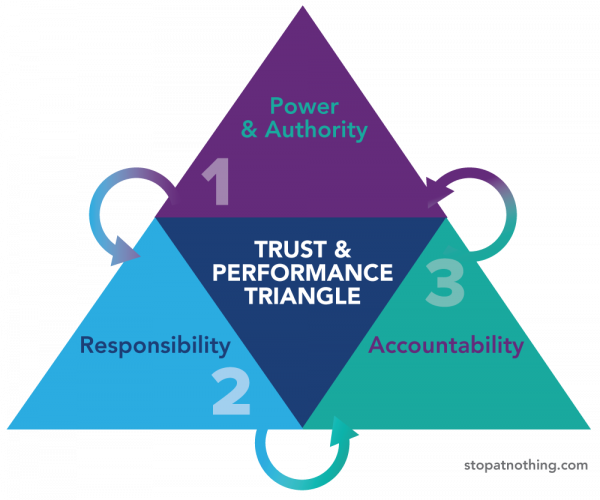By Barry Robertson – March 5, 2018
Learn to use Stop At Nothing’s Trust and Performance Triangle Tool

“My manager hovers over us like a mother hen. He double checks everything on everyone’s desk and swears he is not a micro-manager.”
“There’s no incentive to beat your goals by much. Whether you squeak by or over-deliver, we all get the same 2% increase.”
“Some people spend half their day on FaceBook. There is no accountability, why should I perform my best?”
These responses are typical in some organizations when we interview employees as part of a culture assessment. When people perceive little relationship between performance and rewards or punishment, trust dissolves and performance is reduced. The best employees will leave if they see no accountability for poor performance.
Creating a Merit Based Culture
Good leaders know how all their reports are performing.
It takes caring about performance and your people to create a merit-based culture. Poor leaders, unaware of their impact, treat everyone the same. Whether they are super positive and offer constant praise, or super critical and always finding faults, leaders who are unbalanced rarely create high performing teams.
Stop At Nothing’s Trust and Performance Triangle helps leaders perform the top three vital functions of a manager:
- Empower by providing clarity on goals, objectives, and behaviors.
- Frequently evaluate results and the behaviors to achieve them.
- Deliver rewards and punishments in alignment with performance and behaviors relative to agreed upon expectations.
The Trust and Performance Triangle
Like a three-legged stool, trust and performance breaks down if any of the three legs of the triangle is ineffective. When implemented well, the Trust and Performance Triangle creates a high performance culture.

1. The First Leg: Distributing Power and Authority
First, responsibly give as much power as possible to the people reporting to us. Leaders who hold on to all the power, usually due to fear or ego, create dependencies, become bottlenecks, and stifle employee growth.
Have meetings with each direct report to discuss expectations and boundaries until you are sure that you are both fully aligned. Some negotiations may be needed. Expectations need 100% clarity and include:
- All core goals and objectives to be measured
- Resources needed to be successful
- Behavioral boundaries to ensure positive team impact
- Deadlines, all metrics, and how you will stay engaged
Wise distribution of power and authority goes a long way to improve business results. Clarify and validate every aspect of these expectations, including everything on the list above, by having your direct reports describe them all to you, or put them in writing.
Once alignment is confirmed, you can advance to the second leg of the triangle.
2. The Second Leg: Responsibility
Empowerment means you share responsibility or delegate completely. Frequently engage with each direct report and together inspect what you expect.
Review the results, along with the specific task and behaviors used to achieve the results. Caring, means taking the time to measure results, and collaborate on how to improve performance. Their trust in how much you care has a big impact on motivation. So make sure they know in their hearts, that you want them to succeed.
The next leg of the Trust and Performance Triangle is critically important and often avoided.
3. The Third Leg: Accountability
Accountability ties it all together. This means fairly delivering consequences, rewards and punishments, at appropriate times, in direct proportion with the level of performance.
If the employee’s performance exceeds the goals, provide positive reinforcement in a most effective manner. Remember, rewards are not limited to compensation, but can include recognition, extra training opportunities, or special growth assignments. Consequences may include reduction of responsibilities, compensation, or termination.
If performance fell short, or if non-useful behaviors were displayed, deliver constructive criticism and consequences proportionate with the poor performance. Ensure that employees know that it was their performance, relative to their empowered commitments. Refer them back to leg 1, the agreements, and leg 2, the results, tying together their agreements, results and their performance with the rewards and consequences.
It’s not just you being a tough boss if you deliver a tough message. It was a result of the choices they made, and the performance that followed. Done well, it quickly becomes clear that it is up to them to earn positive rewards.
Stay Engaged
Engage with your employees all year long, formally and informally, discussing their performance and coaching them to success. If your organization still does annual reviews, and you have an employee who is honestly surprised by their review, especially if performance was sub-par, it’s likely you were not as clear in your day-to-day feedback as you thought.
Even if a person is surprised on the upside, it is still a problem. This means the person doesn’t know where they stand and that person has likely been concerned about her or his status.
Empowering Others = Greater Results
If you do a great job with the Trust and Performance Triangle, you will get better at empowering people, and earn their trust and respect. This inspires extra effort and greater performance.
Master this and you will create a merit-based culture in your team, one that motivates everyone to keep learning and improving. If you sustain this structured empowerment process you will find more time for strategic thinking, value-added leadership activities, customer contact, or whatever else is the best use of your newfound time.

Leadership Challenge
Start by focusing on one employee.
- Implement the three steps in the Trust and Performance Triangle with one employee for three months. This way you can to learn from experience how it works in your environment. It takes time at first, but it will save much more time in the long run.
- Once you’ve mastered the challenge with one employee, commit to use this method with all of your direct reports, and enjoy the results!
